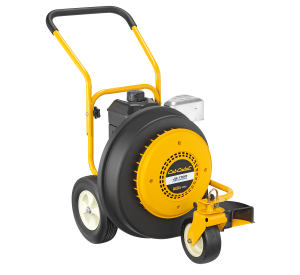 Cub Cadet’s JS1150 leaf blower is a powerful alternative to handheld models, with excellent wind speed and air volume for quick cleanup in expansive outdoor areas. All of this impressive power comes with a few safety risks, however. Equipment owners need to make sure that they’re follow Cub Cadet’s safety guidelines and operational best practices as they use the JS1150 leaf blower to get the job done, in order to reduce the risk of serious injury to themselves and others. Before getting started, make sure to review the company’s guidelines for general operation, blower service, and other scenarios where injury might occur if precautions aren’t followed.
Cub Cadet’s JS1150 leaf blower is a powerful alternative to handheld models, with excellent wind speed and air volume for quick cleanup in expansive outdoor areas. All of this impressive power comes with a few safety risks, however. Equipment owners need to make sure that they’re follow Cub Cadet’s safety guidelines and operational best practices as they use the JS1150 leaf blower to get the job done, in order to reduce the risk of serious injury to themselves and others. Before getting started, make sure to review the company’s guidelines for general operation, blower service, and other scenarios where injury might occur if precautions aren’t followed.
1. Safety During General Operation
One of the best ways to reduce the risk of injury while operating a JS1150 leaf blower, or any type of power equipment, is to take time to become familiar with its instruction manual. Cub Cadet’s JS1150 leaf blower comes with instructions printed on the equipment’s surface and in a separate instruction manual, which will help operators learn best practices, operating procedures, and more. The instruction manual also clarifies each the blower’s controls and functions so that they can be used safely, in the proper outdoor setting.
In addition to reviewing printed instructions and guidelines, equipment owners should remember that the equipment is designed to complete serious landscaping tasks. It is not a toy, and should not be used like one around the home. The leaf blower should be operated only when all children, pets, and other bystanders have cleared the area and gone indoors. This is simply the best way to avoid causing injuries due to debris and projectiles that often are a result of the massive air volume produced.
Proper leaf blower safety also includes wearing the right clothes for the job. It’s recommended that operators wear pants and a shirt that fully cover the arms and legs, as well as proper footwear that covers the foot entirely. The equipment should be properly assembled, with a discharge chute in place, and the blower should be positioned so that debris is not blown in the direction of windows, doors, cars, or bystanders.
2. Leaf Blower Safety Around Children
Because of its raw power and its potential to produce projectiles, the JS1150 should never be used in the presence of children. Before turning the equipment on, make sure that young children are inside the home and away from any areas where debris and projectiles might cause serious injury to occur. If children of any age enter the area where the blower is being used, turn the equipment off immediately and address the situation. Finally, make sure that the blower is not operated by anyone under 14 years of age.
3. Staying Safe While Handling Gasoline
The JS1150 is a gas-powered leaf blower, and that means operators need to review basic safety guidelines for handling this highly flammable fuel. First and foremost, make sure that gasoline is placed into an approved container and that this container is tightly sealed. One of the best ways to prevent injury is to prevent gasoline from leaking or splashing onto other surfaces, including clothing. While handling gasoline, make sure that the leaf blower’s engine is cool, and that it has no way of accidentally turning on while refueling.
The area where gasoline is handled should be properly ventilated and free of cigarettes or other objects that might spark a flame. If any fuel is spilled while refueling, it should be immediately wiped away. Wait at least 5 minutes after cleaning up a fuel spill to resume refueling or to turn on the leaf blower’s engine.
4. Tips for Safety During General Service and More
General service tips can help keep operators safe even while performing routine maintenance and equipment checks. Keep in mind that the JS1150 comes with several essential safety mechanisms in place, and avoid removing or tampering with these mechanisms for any reason. Before operating the blower, check the integrity of each safety component, as well as the nuts, bolts, and other parts that keep the equipment safe and operating at peak efficiency.
Be sure to maintain the safety labels and keep the instruction manual available at all times. If the manual or safety labels become damaged, missing, or hard to read, order replacements from Cub Cadet. This is a key way to keep safety concerns top of mind, and to ensure that proper procedures are followed for the lifetime of the leaf blower.
Maintain the JS1150 with OEM Parts fro CubParts.com
Safe operation, maintenance, and repairs are a key part of owning Cub Cadet’s JS1150 leaf blower. At CubParts.com, equipment owners can search for replacement parts by their individual part number, the JS1150 model number, or the engine type that their equipment uses. Better yet, the online search tool returns OEM replacement parts that adhere to Cub Cadet’s top-notch standards for quality, compatibility, and long-term durability. For this reason, there’s no easier way to find replacement parts that will maximize safety and equipment quality over the long-term.
